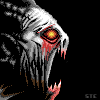-
Posts
5,295 -
Joined
-
Last visited
-
Days Won
16
Reputation Activity
-
 Rozovian got a reaction from Nostalvania in Mega Man III - Spark Man (Funk/Jazz/Electronic)
Rozovian got a reaction from Nostalvania in Mega Man III - Spark Man (Funk/Jazz/Electronic)
Dat groove. I'm digging this.
Pan effects are a little annoying on headphones, but no biggie. I hear source interpreted, it's recognizable and arranged, nothing stands out as bad. The strings might not be a convincing performance, but that hasn't stop tracks from being accepted. It might be a little soft in terms of levels (headphones, new setup, difficult to compare), but if you're satisfied with the levels, it's better to leave them as is than to mess with the dynamics and introduce compression problems. It's easier for listeners to turn the volume up than to turn the compression down.
I'd be surprised if it was rejected. Excellent work.
-
 Rozovian got a reaction from zazabar in What am I missing?
Rozovian got a reaction from zazabar in What am I missing?
Neblix already covered melodies rather well, so I'll focus on instrumentation and mixing. There's also rhythms, but I'll let someone else cover that.
Let's use Prisoners for this example.
0:00 Right from the start, the drums stand out in a bad way. This is when you need to figure out what kind of sound you want, and design that sound. Drums are often layered, so that eg two snares with different good qualities are combined into the same snare sound, maybe one with a nice strong attack and the other with a nice long body and tail. They are also processed with different effects to make sure they have their own place in the mix... that they're the right amount of loud at the right time at the right frequencies.
0:04 Once the chords come in, the bells are probably too loud and clutter up the soundscape with their shrill sound. I would bring down their levels quite a bit there, and again when the piano comes in, if I wouldn't remove them entirely at that point in favor of a cleaner mix. I could also combine the bell melody with the slower melody that comes in with the chords, to cover that range and bring a bit more rhythm to the track, but that's not mix/sound design.
0:13 The piano is rather loud and rather exposed, and has an annoying reverb. I would soften its reverb. I'd adjust the piano's sound to give it a little more punch, just so I could play it at a lower level and still have it get through enough.
0:30 The bass is panned. Don't do that. Most of the time, the bass works best centered, for both technical and aesthetic reasons. I won't go into the bass' rhythm or melody. It plays on top of the kick drum, and has a similar kind of sound. That doesn't work, because I can't hear the kick anymore after the bass started playing. For some genres, you'd want the kick to peak at a lower frequency than the bass, for some genres vice versa, but you don't want them to fight over the same frequency. This is where you change one of them so it has different qualities, eg stronger sub, punch at a different frequency, brighter overall sound... The synths/samples you use affect this the most, so adjusting those is the best course of action here. Other solutions include transposing the bass, and separating them with an equalizer.
0:48 The trance synth doesn't quite fit the aesthetic. There's also a ton of stuff happening in the track right now, making it a mess to listen to, especially as there is no clear lead. This is both a mixing and an arrangement issue. The mixing issue is best solved by picking a track to be the lead, deciding a frequency range that it's got a clear sound in, and cutting down that frequency a little from the other instruments. It's good to do, but it's not a replacement for solving problems in the arrangement.
My guess is that you're using a lot of presets without modifying them much. timaeus already suggesting learning to make your own sounds. Even if you go back to presets after that, you'll know how to adjust those presets to better fit the rest of the instrumentation. Beyond fiddling with the instruments themselves, you should learn how to use effects. the basic ones, the ones everyone into this should know the basics of, are equalizer, compressor, reverb; and most importantly and often neglected: track level (volume).
This track isn't that different than the stuff I made when I was 16, except you've turned to people for criticism much earlier than I did, and are taking music courses in college. Learn to identify things you're not happy with, and find solutions to those things. That's how you learn.
-
 Rozovian got a reaction from ILG924 in High quality videogame sound?
Rozovian got a reaction from ILG924 in High quality videogame sound?
Those soundfonts are already processed to have a cohesive sound when used together, and they'll fit a less realistic aesthetic anyway. The more realistic you make things, the more you have to worry about sounds fitting together. Some people can tell when you're using different reverbs on different instruments, and this would be a problem for them listening to an otherwise realistic piece, but one made of soundfonts won't bother them as much because it's not trying to be realistic.
Maybe a soundfont aesthetic is what you should be shooting for. Maybe you should sketch out your ideas with a single instrument (I use a Rhodes sound for my sketches).
If you're looking to construct higher-quality sounds, look at the spectrum of a single note, and try to recreate that. Look at the waveform. An organ sound could probably be recreated with an additive synth. I would probably try Absynth, if I didn't find any good sampled instruments to work with. I could also look at the waveforms available in ES2 and try a combination of oscillators in FM8, even make something out of Pianoteq that resembles that kind of organ. But first I have to know the component frequencies of the sound, and that's best seen with a good spectrum analyzer looking at a single note. Comparing that single note and a single note from your replacement instrument will be very useful in getting the balance just right. Then you'd have to match other qualities of its sound, such as envelope, resonances, and reverb.
Though the idea of making a synth sound realistic might seem super difficult, it's actually not as hard as it sounds... depending on the sound. Strings, especially solo? Very difficult. Woodwinds? Easy. An organ isn't that different from a woodwind, it just has more component frequencies.
If the idea of component frequencies is too foreign for you, know that they will most likely be multiples of the note's fundamental frequency. If that's 100Hz, the next frequency is (assuming full set of harmonics) is at 200Hz, the next at 300Hz, the next at 400Hz... Am I making it too complicated? In an additive synth, you'd likely have this series listed in order, and you'd see an ascending set of frequencies in the spectrum analyzer, too.
For the organ, I would probably synthesize it. Other sounds I might find in sample libraries. Some sounds I might not find or be able to make a similar instrument of, but could swap it out for something with a different sound that still sounds okay in the mix. You get used to the sound you've got. That's why I don't use low-quality sounds to sketch out my music - I don't want to get used to that sound and struggle to break away from it, as you now do.
-
 Rozovian got a reaction from SJTR5 in Chaos Factory - Chemical Plant (Zone 2) Sonic The Hedgehog 2
Rozovian got a reaction from SJTR5 in Chaos Factory - Chemical Plant (Zone 2) Sonic The Hedgehog 2
Sound effects. Great. Not a fan of them, most of the time. They're annoying. There's some cool rhythmic uses of them here, but not enough to make me like them. Not everyone will.
The melodic parts here are really loud. If they're high pitched, they already cut through a lot, so they don't need to be as loud. The many shrill, ringing things could be less so. It also sounds like the track is missing mid-range instrumentation. Though the bass get rather high at times, something in the mid range would probably help with the balance.
Sound design seems to draw a lot from the fm synthesis of the original. Cool. It runs the risk of being cheap sound design, but I think it's a cohesive sound design aesthetic, so I don't mind.
Structurally, this track is all over the place. On the whole, the sound design and recurring elements keep it together. Source is there, and I like the arrangement. But there are parts where it feels a bit aimless. The big change at 2:02-2:12 is one of the stranger parts of the track, but it soon finds some familiar elements again so I don't think it's a big problem. A more clear direction might help, but that's difficult to create out of an existing arrangement without messing it up.
Mixing is a mess. I have concerns about other parts, and I don't like sound effects, but I don't think the other things are problematic to the extent the mixing is.
-
 Rozovian got a reaction from hleet_tahiti in Finding myself too dependant of "real instruments"
Rozovian got a reaction from hleet_tahiti in Finding myself too dependant of "real instruments"
Challenge yourself.
For learning synths, make a song using only presets of actual synths (no samples). Think of all instruments in terms of timbre rather than as synths, samples, or recorded instruments. Read about how different kinds of synthesis works. Create an initialized patch of a relatively easy synth. Experiment with it. Make your own instrument patches for it. Make a song with only original patches. Make a song without any added effects so that all the mixing (eq, levels, reverb) has to be done in the synths themselves, preferably in a synth that doesn't have its own effects so you're just using the filter and envelopes and other principal parts of the synth to mix it.
I did stuff like that, and I can now create the kinds of sounds I want. I tend to use FM8 these days for most of my synthesis needs, as it suits my style, but Omnisphere and Logic's built-in synths are just as useful. For freebies, I recommend TAL's synths; Elek7ro II and Noisemaker are versatile but not too complicated. FL should have some built-in synths you can use, too.
-
 Rozovian got a reaction from Eino Keskitalo in Workshop Discussion and Guidelines (read before posting!)
Rozovian got a reaction from Eino Keskitalo in Workshop Discussion and Guidelines (read before posting!)
For those having problems getting a mod review, there are some quirks of the new forum software that complicates things. In the old forums, it was just a matter of selecting mod review from a list of approved and predefined thread prefixes. Now you have to write it yourself... and spell it correctly. Here's a few tips on how to get it right:
1. Spell it with a hyphen. Mod-Review, mod-review; uppercase or lowercase doesn't matter, but whether there's a space or a hyphen matters. The quick link for mods has been updated to cover all these spellings, but if a mod just clicks on the tag, they'll only get the threads with the tag spelled the same way. The old forum had it spelled with a hyphen, so we'll stick with that.
2. Make sure to check the "Use first tag as prefix", as that's the most visible way to mark your thread for mod review. Also, make sure to enter mod-review as the first tag in the tags field.
3. You change tags in the Full Editor.
4. If these things don't don't change anything or if you still aren't getting a mod review, PM a mod or two directly. We're here to help. Let us know if we've missed your thread (give us a week or two, though, but if it's been a month, PM us).
--
And while we're at it, do you think there are too many pinned topics on the board?
-
 Rozovian got a reaction from timaeus222 in Beginner remix melodies and DnB basics
Rozovian got a reaction from timaeus222 in Beginner remix melodies and DnB basics
Yeah, Jamison's DnB is something I'm also a fan of. I've been trying to hit that style myself, but I can't make it as good. Besides suggesting you have a look at my remixing guide (it's in my sig) for more general remixing advice, I've got little to say about the production side of DnB. So let's talk sources instead.
The most versatile sources tend to be the rather simple ones. Koji Kondo's music is often this, and NES- and SNES-era music is often this. Ironically, the Super Mario Bros theme is _not_. I got started on Super Metroid, Red Brinstar in particular, and I've got a DnB mix of it I'm working on (and failing to be satisfied with the mix). It's a source with a simple backing pattern that can be used in different ways, and a few lead melodies that play over it. Another commonly remixed track with similar qualities is Corridors of Time from Chrono Trigger, also with a simple backing pattern and a lead on top.
The benefit of using sources like this is that the backing pattern is often distinct enough to use to build the rhythm of the track with, along with the drums, but simple enough that you can do a lot with the bass things underneath (Ekaj's take on Red Brinstar, for example, has a great bass sequence).
The melody of course has to fit the mood of the genre, or be malleable enough to work there. Sometimes that means taking a melody and putting it in a different mode or scale. Breaking the rhythm of a melody and adapting it to a different rhythm means you have to figure out what the important notes of it are, and how to time those to the new rhythm. This is more art than science, and one of those "I know it when I hear it" things. I encourage you to experiment with this. For a take on melodies, I suggest you look at what WillRock did with an upbeat, major key Pokémon track. Both Will and I have a tendency to mess with melodies; my approach tends to be to cut them into tiny pieces and put those pieces to new uses, while Will tends to jump around chords and modes to adapt the melody to new things. Either approach could work for DnB.
I suggest you download the chiptune archives from ocr or other sources and listen for interesting sources. What you're looking for are tracks that have elements that could be adapted to DnB. Naturally, there's nothing magical about chiptunes that makes them better suited for this than any other kind of music, but the melodies are a lot more accessible than in non-chiptune compositions, and there's insane amounts of chiptunes to examine. If you're less inclined to look for music yourself, go on YouTube and search for people's favorite VGM lists, and listen for elements that you can use. Once you find something, have a closer look at that game's soundtrack and see what you find.
-
 Rozovian got a reaction from Eino Keskitalo in Beginner remix melodies and DnB basics
Rozovian got a reaction from Eino Keskitalo in Beginner remix melodies and DnB basics
Yeah, Jamison's DnB is something I'm also a fan of. I've been trying to hit that style myself, but I can't make it as good. Besides suggesting you have a look at my remixing guide (it's in my sig) for more general remixing advice, I've got little to say about the production side of DnB. So let's talk sources instead.
The most versatile sources tend to be the rather simple ones. Koji Kondo's music is often this, and NES- and SNES-era music is often this. Ironically, the Super Mario Bros theme is _not_. I got started on Super Metroid, Red Brinstar in particular, and I've got a DnB mix of it I'm working on (and failing to be satisfied with the mix). It's a source with a simple backing pattern that can be used in different ways, and a few lead melodies that play over it. Another commonly remixed track with similar qualities is Corridors of Time from Chrono Trigger, also with a simple backing pattern and a lead on top.
The benefit of using sources like this is that the backing pattern is often distinct enough to use to build the rhythm of the track with, along with the drums, but simple enough that you can do a lot with the bass things underneath (Ekaj's take on Red Brinstar, for example, has a great bass sequence).
The melody of course has to fit the mood of the genre, or be malleable enough to work there. Sometimes that means taking a melody and putting it in a different mode or scale. Breaking the rhythm of a melody and adapting it to a different rhythm means you have to figure out what the important notes of it are, and how to time those to the new rhythm. This is more art than science, and one of those "I know it when I hear it" things. I encourage you to experiment with this. For a take on melodies, I suggest you look at what WillRock did with an upbeat, major key Pokémon track. Both Will and I have a tendency to mess with melodies; my approach tends to be to cut them into tiny pieces and put those pieces to new uses, while Will tends to jump around chords and modes to adapt the melody to new things. Either approach could work for DnB.
I suggest you download the chiptune archives from ocr or other sources and listen for interesting sources. What you're looking for are tracks that have elements that could be adapted to DnB. Naturally, there's nothing magical about chiptunes that makes them better suited for this than any other kind of music, but the melodies are a lot more accessible than in non-chiptune compositions, and there's insane amounts of chiptunes to examine. If you're less inclined to look for music yourself, go on YouTube and search for people's favorite VGM lists, and listen for elements that you can use. Once you find something, have a closer look at that game's soundtrack and see what you find.
-
 Rozovian got a reaction from Jorito in What am I missing?
Rozovian got a reaction from Jorito in What am I missing?
If you're talking about modern video game music, you're not likely to make it _better_, even after yours of experience. But making it better shouldn't be your goal, either. Your goal should be to make it your own. Have a listen to a few remixes of recent games and compare them to the originals. You'll find that the remixes are often in a new genre, have a new mood, or does something very differently.
With older source materials, especially chiptunes and their like, they were limited in polyphony, instrument realism, and mixing. Those are easier to just upgrade, but that's not nearly as much fun as taking the melodies out of them and putting them in a new context, be that a specific instrumentation, genre, mood, rhythm, or something else. You can look at the different remixes of the same source to find how people have used the same melodies to different results.
Another way to approach it is to think about your skills, your sound, the kind of music you can make. What source would be a good fit for that? Some remixers are guitarists and most of their remixes rely heavily on guitars. Some remixers are club-oriented producers, and make music that'd fit the club scene. Some remixers mostly just play piano. Some remixers make orchestral arrangements. Some remixers are real-life jazz bands. Some remixers make things more like covers. Some remixers twist the source so it's barely recognizable. Some remixers play cello and make chiptunes. Whatever your skillset, whatever the style of music you make; what would be a good source to remix in that style?
A very educational approach is to pick a style (eg Pendulum) and try to remix something into that style. It'll teach you structure, it'll give you a reference track to compare production and performance to, and you'll be forced to adapt the source in different ways to make it fit. Some melodies are easier than others. The theme from Halo would be easy to adapt to almost anything. Some sources can be very difficult because what makes them recognizable is the style more than the melody itself, like the strange scale used in the Left 4 Dead games' music.
If your thing isn't "better than Koji Kondo" but instead "what if x... had lyrics" or "everything can be a waltz" or "all synth, all original synth patches" or something like that, you've got your own thing. Do that instead. Have many things of your own to try, and see which ones work. In my case, it's been chopping up the source, and basslines. Mostly.
This isn't an exhaustive list of ways to remix things, either.
-
 Rozovian got a reaction from Garpocalypse in FTL-Fate of My Crew (Milky Way Battle)
Rozovian got a reaction from Garpocalypse in FTL-Fate of My Crew (Milky Way Battle)
First, apologies for the very late mod review.
Some weird timing things in the intro. I don't terribly mind, but I'd be remiss not to mention it.
Slow attack on the string thing 0:50 makes it sound like it's lagging behind. Sounds like a crash is missing from 1:01, and from similar places later as well. Nice piano sound 1:13. Hats and cymbals could be a little louder and a little brighter, because I can barely hear them. It's not just my ears, is it?
Overall needs to be louder. Not necessarily by much, but it's lacking impact on my setup. I would probably fiddle with the compression, add side-chaining or give the parts that should have more impact a tiny nudge in level, maybe all of these.
At 2:50 I'm hoping it'd end. Seeing it's only about half way, I'm a bit concerned about how it'll work. I'm glad you're changing it up after that point, but I wonder if it's a little too late. Giving the earlier parts more impact might solve this.
I would look into mixing up the chord sequence some, though. It's currently just Em-D-C-D through most of the track. No wonder it gets repetitive. Even if you don't change it much, you can do a lot by switching one or two of the chords every once in a while, to signal a new part, to serve as punctuation, whatever. You can swap out either D for a Bm(7), the C for a G or Am, depending on the notes you use in the other parts. The Em works well to keep the mood, but you can swap it for an Em7 or a G/E from time to time. Modifications to an otherwise repeating chord sequence is a way to signal progression to the listener, and helps keep the track a little more interesting. It might not always be necessary, but it often helps.
Snare sounds like it's lacking mids. You could easily bring down the synth lead and give the snare a bit more mids instead. Ending is really cool.
Source is there, nicely adapted. I'm cool with the source usage.
Overall, nice work. It might be a pass, but I would personally want it to be better before I was satisfied.
-
 Rozovian got a reaction from timaeus222 in What am I missing?
Rozovian got a reaction from timaeus222 in What am I missing?
If you're talking about modern video game music, you're not likely to make it _better_, even after yours of experience. But making it better shouldn't be your goal, either. Your goal should be to make it your own. Have a listen to a few remixes of recent games and compare them to the originals. You'll find that the remixes are often in a new genre, have a new mood, or does something very differently.
With older source materials, especially chiptunes and their like, they were limited in polyphony, instrument realism, and mixing. Those are easier to just upgrade, but that's not nearly as much fun as taking the melodies out of them and putting them in a new context, be that a specific instrumentation, genre, mood, rhythm, or something else. You can look at the different remixes of the same source to find how people have used the same melodies to different results.
Another way to approach it is to think about your skills, your sound, the kind of music you can make. What source would be a good fit for that? Some remixers are guitarists and most of their remixes rely heavily on guitars. Some remixers are club-oriented producers, and make music that'd fit the club scene. Some remixers mostly just play piano. Some remixers make orchestral arrangements. Some remixers are real-life jazz bands. Some remixers make things more like covers. Some remixers twist the source so it's barely recognizable. Some remixers play cello and make chiptunes. Whatever your skillset, whatever the style of music you make; what would be a good source to remix in that style?
A very educational approach is to pick a style (eg Pendulum) and try to remix something into that style. It'll teach you structure, it'll give you a reference track to compare production and performance to, and you'll be forced to adapt the source in different ways to make it fit. Some melodies are easier than others. The theme from Halo would be easy to adapt to almost anything. Some sources can be very difficult because what makes them recognizable is the style more than the melody itself, like the strange scale used in the Left 4 Dead games' music.
If your thing isn't "better than Koji Kondo" but instead "what if x... had lyrics" or "everything can be a waltz" or "all synth, all original synth patches" or something like that, you've got your own thing. Do that instead. Have many things of your own to try, and see which ones work. In my case, it's been chopping up the source, and basslines. Mostly.
This isn't an exhaustive list of ways to remix things, either.
-
 Rozovian got a reaction from Jorito in What am I missing?
Rozovian got a reaction from Jorito in What am I missing?
Keep in mind that the final result is a combination of things. I generalize those things into three groups: the writing, the performance, and the production. Music theory is all about the writing, or what to play. Performance is how to play it. Production is how to make it sound good for the listener.
You can think of music as voice acting. Writing is the words, obviously. Performance is the voice. Production is the microphone.
In electronic music, the performance takes a back seat to sound design, but they serve to fill the same role, which is to infuse the notes with emotion that the notes themselves don't have. Changes in timbre, timing and strength combine to create an illusion of performance.
In your case, I would just keep making music, seeking out criticism and advice, trying new things, studying new things, listening to all kinds of music, and overall engaging with music in every way. I've seen that OCR is a pretty good community for this stuff, as it takes around 2 years for remixers to get their remixes posted here. Some have more experience than others, and get there faster. Others come here with little or no music skill and it takes a little longer. Those with more time and energy to put into the remixing get there sooner. It takes years to get good at this, years of making music, learning new things, finding mistakes, and developing your skills.
The most important skill to develop is your critical ear.
-
 Rozovian got a reaction from timaeus222 in What am I missing?
Rozovian got a reaction from timaeus222 in What am I missing?
Keep in mind that the final result is a combination of things. I generalize those things into three groups: the writing, the performance, and the production. Music theory is all about the writing, or what to play. Performance is how to play it. Production is how to make it sound good for the listener.
You can think of music as voice acting. Writing is the words, obviously. Performance is the voice. Production is the microphone.
In electronic music, the performance takes a back seat to sound design, but they serve to fill the same role, which is to infuse the notes with emotion that the notes themselves don't have. Changes in timbre, timing and strength combine to create an illusion of performance.
In your case, I would just keep making music, seeking out criticism and advice, trying new things, studying new things, listening to all kinds of music, and overall engaging with music in every way. I've seen that OCR is a pretty good community for this stuff, as it takes around 2 years for remixers to get their remixes posted here. Some have more experience than others, and get there faster. Others come here with little or no music skill and it takes a little longer. Those with more time and energy to put into the remixing get there sooner. It takes years to get good at this, years of making music, learning new things, finding mistakes, and developing your skills.
The most important skill to develop is your critical ear.
-
 Rozovian got a reaction from timaeus222 in What am I missing?
Rozovian got a reaction from timaeus222 in What am I missing?
Neblix already covered melodies rather well, so I'll focus on instrumentation and mixing. There's also rhythms, but I'll let someone else cover that.
Let's use Prisoners for this example.
0:00 Right from the start, the drums stand out in a bad way. This is when you need to figure out what kind of sound you want, and design that sound. Drums are often layered, so that eg two snares with different good qualities are combined into the same snare sound, maybe one with a nice strong attack and the other with a nice long body and tail. They are also processed with different effects to make sure they have their own place in the mix... that they're the right amount of loud at the right time at the right frequencies.
0:04 Once the chords come in, the bells are probably too loud and clutter up the soundscape with their shrill sound. I would bring down their levels quite a bit there, and again when the piano comes in, if I wouldn't remove them entirely at that point in favor of a cleaner mix. I could also combine the bell melody with the slower melody that comes in with the chords, to cover that range and bring a bit more rhythm to the track, but that's not mix/sound design.
0:13 The piano is rather loud and rather exposed, and has an annoying reverb. I would soften its reverb. I'd adjust the piano's sound to give it a little more punch, just so I could play it at a lower level and still have it get through enough.
0:30 The bass is panned. Don't do that. Most of the time, the bass works best centered, for both technical and aesthetic reasons. I won't go into the bass' rhythm or melody. It plays on top of the kick drum, and has a similar kind of sound. That doesn't work, because I can't hear the kick anymore after the bass started playing. For some genres, you'd want the kick to peak at a lower frequency than the bass, for some genres vice versa, but you don't want them to fight over the same frequency. This is where you change one of them so it has different qualities, eg stronger sub, punch at a different frequency, brighter overall sound... The synths/samples you use affect this the most, so adjusting those is the best course of action here. Other solutions include transposing the bass, and separating them with an equalizer.
0:48 The trance synth doesn't quite fit the aesthetic. There's also a ton of stuff happening in the track right now, making it a mess to listen to, especially as there is no clear lead. This is both a mixing and an arrangement issue. The mixing issue is best solved by picking a track to be the lead, deciding a frequency range that it's got a clear sound in, and cutting down that frequency a little from the other instruments. It's good to do, but it's not a replacement for solving problems in the arrangement.
My guess is that you're using a lot of presets without modifying them much. timaeus already suggesting learning to make your own sounds. Even if you go back to presets after that, you'll know how to adjust those presets to better fit the rest of the instrumentation. Beyond fiddling with the instruments themselves, you should learn how to use effects. the basic ones, the ones everyone into this should know the basics of, are equalizer, compressor, reverb; and most importantly and often neglected: track level (volume).
This track isn't that different than the stuff I made when I was 16, except you've turned to people for criticism much earlier than I did, and are taking music courses in college. Learn to identify things you're not happy with, and find solutions to those things. That's how you learn.
-
 Rozovian got a reaction from thorlius in Seiken Densetsu 3: Songs of Light and Darkness - History
Rozovian got a reaction from thorlius in Seiken Densetsu 3: Songs of Light and Darkness - History
No idea what was shown, but ocr staff has the release schedule, so they'd know what gets released this year, and several of them are involved in OCU. The album is done and being evaluated by ocr staff. There's still a few things (art and website-related, mostly) that we need to do before we could release this.
You're not the only one looking forward to this album's release. With the music being done, it irks me that we can't just release the album right now (or even months ago), but ocr has an album release schedule and queue for a reason. We should be ready for release this year, but the actual release seems to be next year. Can't cut in line.
-
 Rozovian got a reaction from djpretzel in Seiken Densetsu 3: Songs of Light and Darkness - History
Rozovian got a reaction from djpretzel in Seiken Densetsu 3: Songs of Light and Darkness - History
I'm on it. PMd.





















